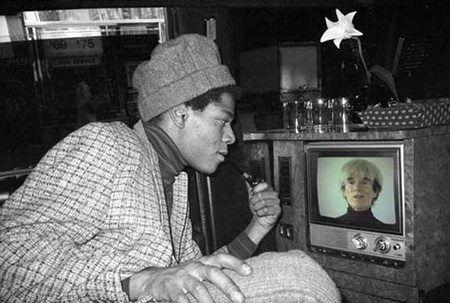
Continuing through April 3, 2016
Capturing a zeitgeist is a tricky proposition. As diligently as one might endeavor to negotiate the intersection of fact, fiction, and nostalgia, one may as well try to “hold a moonbeam in your hand,” as a quintet of flustered nuns did in “The Sound of Music,” trying to solve the problem of Maria. Of late, a bevy of contemporary artists and curators has aimed its collective rear-view mirror at the East Village art scene of the 1980s. Artist Paige Powell tossed her hat into that retro ring in 2014 with a suite of nude photographs of Jean-Michel Basquiat — whom she dated from 1982 to 1984 — exhibited at The Suzanne Geiss Company in New York.
Now, Powell follows up that effort with a sprawling exhibition, “The Ride.” A fifth-generation Oregonian, Powell left Portland for New York in 1980. Beautiful, smart, and ambitious, she had a knack for sniffing out and becoming indispensible to the right people. She landed a job at “Interview” magazine, hooked up with Basquiat, and began chronicling the comings and goings at Andy Warhol’s “Factory” via film and videotape. Thirty-plus years later, with the help of friends, she has sifted through her archival treasure trove and reconstituted a host of halcyon relics into the current show, co-curated by Julia Dolan and Brian Ferriso.
The exhibition consists of three parts. The first is an elegant selection of nine black-and-white photographs, dating from 1982 to 1986 and documentary in nature: Warhol lunching at Mr. Chow, his omnipresent camera in hand; a languid Kenny Scharf in his studio; and other would-be ephemera that have gained significance thanks to the art market’s myth-making machine. The second component, an installation called “Beulah Land (162 Avenue A) opening, January 15, 1984,” displays more than 800 snapshots Powell took during her decade in New York and afterwards, when she returned to Oregon. Early-vintage Madonna is here, as are Jack Nicholson and Grace Jones, along with Portland denizens such as filmmaker Gus van Sant, Pink Martini bandleader Thomas Lauderdale, and poet Walt Curtis. The show’s third and largest component is the three-channel video installation from which the exhibition takes its title. In “The Ride,” three identical photographs of Basquiat watching television extend across a 50-foot wall, a nod to Warhol’s penchant for seriality. On each television screen, digitally projected videos by Powell capture Warhol being interviewed, Keith Haring painting, and both of those artists walking around Manhattan. The audio component, unfortunately and inexplicably muddled, was mixed by photographer David LaChapelle. This is the first time these videos have been publicly screened.
Complementing Powell’s geo-generational séance is a new “Cosmic Cavern” by Scharf, an immersive installation that beckons viewers inside a circular room painted Day-Glo colors, tagged with graffiti, and littered with old VHS and Betamax tapes. It’s a veritable time capsule, with disco tunes blaring from a boom box, Slinkies strung from the ceiling and long-obsolete computer keyboards strewn about on the floor. There’s not much to do inside— you can sit on a beanbag or beach lounger if you want — and on the whole, the environment, although fun at first blush, feels more like a suburban teenager’s den than an East-Village happening. Of course, it’s impossible to time warp the energy of a Studio 54 or CBGB into a museum exhibit circa 2016. What Powell and Scharf wind up demonstrating, ultimately, is that photos and props are a paltry substitute for firsthand experience. Approximating a vibe is not the same as actually conveying it. In the end, sad but true, you really had to be there.
